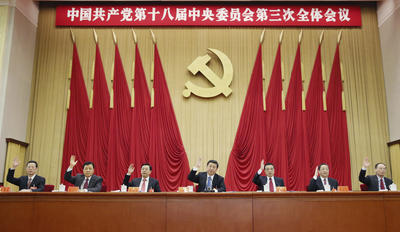Major reform and structural change are necessary for China to sustain growth and enter the ranks of developed countries. Chinese reform and economic growth over the past three-and-a-half decades have been successful, but it would be unwise to presume that China can smoothly transition to an advanced economy.
The old growth model had side effects that became less acceptable to the Chinese people as their incomes rose. Domestic demand has increased, but relatively little has come from expanded consumption and consumption choices remain limited. Wages and rural incomes have been rising rapidly, but this has failed to stem rising income inequality. Official corruption has increased and, despite meeting targets for reductions in energy and emissions intensity, the environmental challenge remains formidable.
Other side effects such as the tendency towards trade surpluses, real estate bubbles and unregulated growth of debt threaten economic stability. Diverse patterns of business ownership have emerged with the expansion of the market economy, requiring complex institutional innovation to ensure effective regulation.
The continued large role of the state is a problem for the efficient operation of some markets, because it hampers productivity growth, which is necessary to sustain reasonably strong growth. There is resistance to far-reaching reduction of the role of the state. Reforms therefore focus on the readjustment of the respective roles of the state and the market in resource allocation.
Many of China’s problems are not inherently associated with market-oriented development. Rather, they reflect the underdeveloped state of market institutions and regulation. The new model of economic growth aims to foster China’s transition to a modern economy. The decline in the labour force, as a proportion of the total population, heightens the need for reform. This loss of a ‘demographic dividend’ makes increases in productivity through more efficient allocation of resources critical to maintaining growth in living standards.
China’s economic growth has slowed as expected, from around 10 per cent a year from 1992–2011, to a new normal of 7–8 per cent from 2012. The labour force has commenced what will be a long decline, but as yet there is little moderation of high investment expenditure. Maintaining a high investment share with lower growth in output suggests that there will be a considerable decline in the rate of increase in productivity. The decline in productivity needs to be reversed if the desired 7–8 per cent growth rate is to be sustained.
The deepening of reform in the financial sector carries the possibility of a temporary disruption of growth, as risky practices are brought under prudential supervision. If disruption leads to markedly slower growth of output, employment and incomes even for a short period, this will put pressure on the government to move more slowly with reform and resume the expansion of funding through the old state channels. But acceding to these pressures will reduce the chances of China emerging, in a decade or so, as a successful modern economy.
The massive fiscal and monetary expansion in China after the global financial crisis was successful in sustaining employment and income growth, but obscured the need for more fundamental reform aimed at raising productivity. China is now dealing with the negative impact of this policy through deleveraging. This is also why the Chinese government refrains from implementing another large fiscal stimulus package.
Other reforms focus on improved regulation of financial markets to achieve more efficient allocation of capital and reduce the risk of financial crisis. These are closely related to institutional reforms to facilitate expansion of the private sector and more productive use of resources by state-owned enterprises. Local government finances need to be subject to more stringent fiscal discipline to avoid excessive credit expansion and rising debt leading to financial instability. The development of effective land markets is further necessary for economic efficiency and to ease tensions between peasants and the state.
The government has also announced its intention to ease the one child policy. Labour market reforms are closely linked to reforms to social security and health and education. These are important in reducing inequality in income distribution. Policies are directed at turning migrants from rural areas into permanent residents of the cities to encourage migration and allow for a more complete use of their skills. Improved education, especially for children of rural residents and migrants, would increase the quality of the labour force.
One of the guiding principles of Chinese reform is that the transformation from a centrally planned economy to a market economy can’t be achieved in one leap. The Chinese government continues to see China as in transition to a market economy, with government playing an important role in filling gaps left by underdeveloped or imperfect markets. Accepting slower growth must now be part of China’s new model.
Ligang Song is Associate Professor and Director of China Economy Program at Crawford School of Public Policy of the Australian National University.
This article is based on Chapter One of Deepening Reform for China’s Long-term Growth and Development, edited by Ligang Song, Ross Garnaut, and Cai Fang, The Australian National University Press, July 2014. The book will be launched at this year’s annual China Update conference at the ANU.


Thank you for a good overview.
Best wishes
Andrew